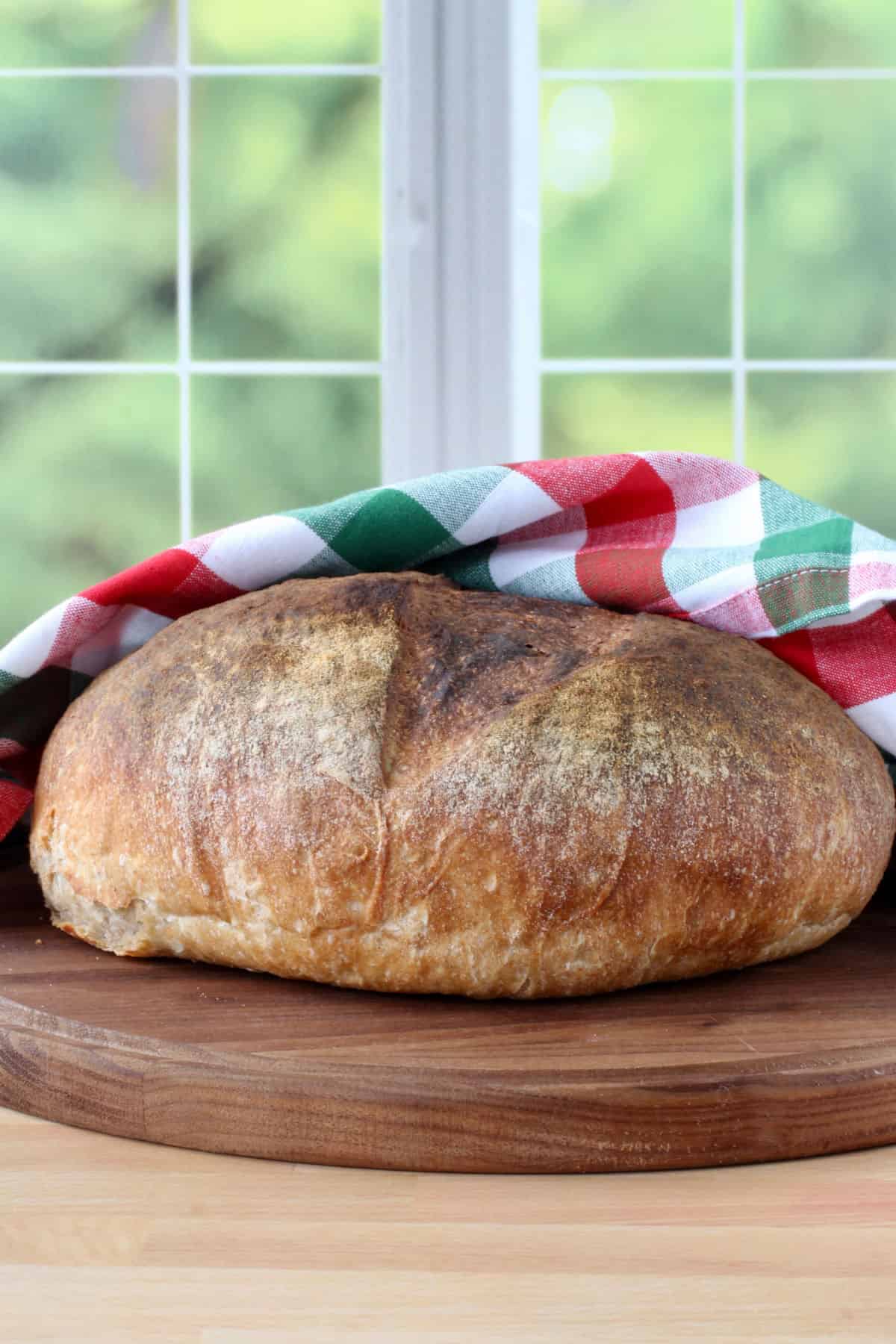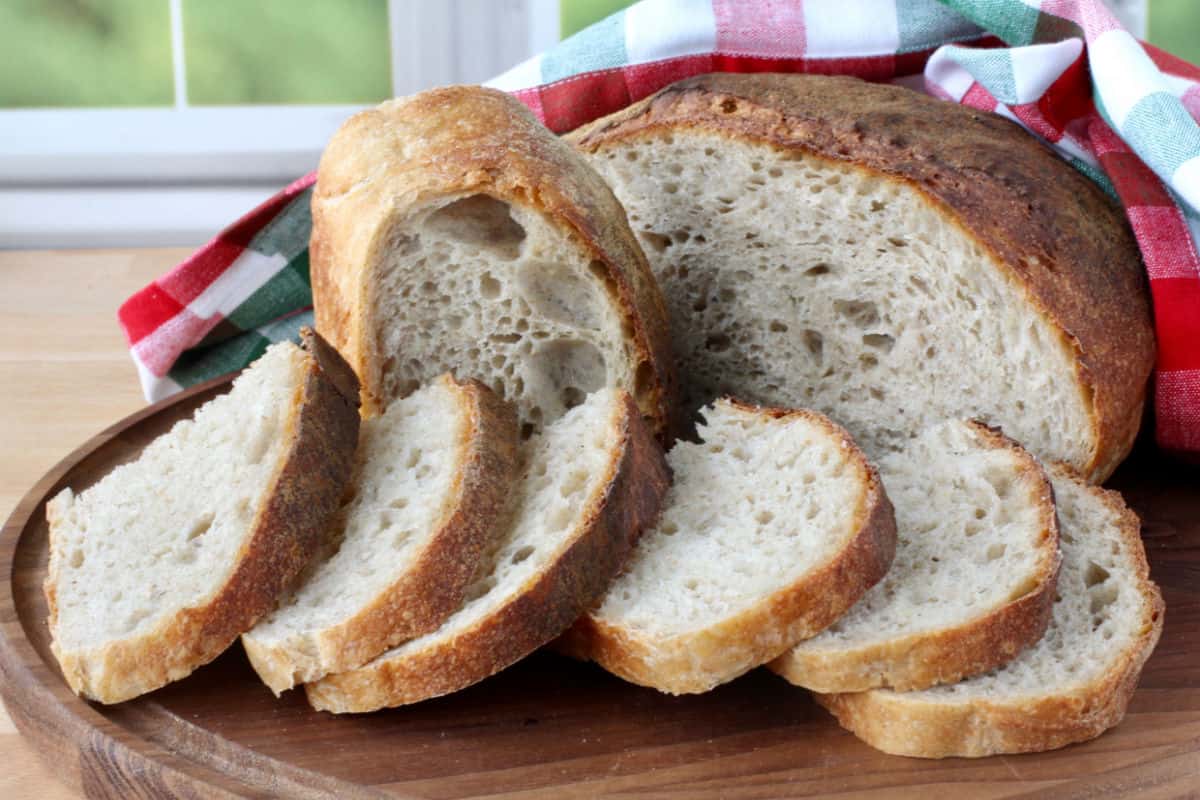This spelt, barley, and white rustic loaf is super easy to make in a morning or afternoon and is a pretty failproof way to capture the flavors of whole spelt and barley while using the structure that bread flour provides.
This spelt and barley bread recipe takes advantage of the wonderful flavors of ancient grains while still maintaining the structure of an airy artisan loaf.
About Spelt and Barley Flours:
Spelt, a type of wheat, is one of the first bread flours. It was originally from the Middle East. It has a nutty-ish flavor and is high in fiber and nutrients. From what I understand, it's also now grown in the U.S., Canada, and Europe.
Barley, while not from the wheat family, is similar in flavor to spelt. It is also high in fiber and nutrients and was originally from the "fertile crescent," which spans parts of the Middle East and southeast Turkey.
Barley is also often used for making malt for use in beer, whiskey, and flavoring (like a chocolate malt or malted milk balls!).
Check out your soup aisle too. Pearl barley is wonderful in soups and stews.
Both spelt and barley are similar in flavor. In fact, combined in this bread, I actually detected the flavor of toast, even when the slices weren't toasted. It was such a unique flavor!
With both spelt and barley, the gluten is not as strong as with bread flour, so I used a 30 percent mix of spelt and barley flours along with 70 percent bread flour for a strong rise and a more open crumb. You can experiment with the percentages and see how the flours behave.
You can also use these flours where gluten development is less important, such as with pita bread and other flatbreads. They can also be used in cakes and cookies, where you don't want a lot of gluten development.
Many bakers use a much higher percentage of spelt with great success, especially with white spelt. You can even use it to feed your starter. My most daring bake was with about 30 percent spelt and 60 percent einkhorn, another ancient grain, plus a white wheat sourdough starter.
Ingredients:
Besides the three flours, all you need is water, salt, and instant yeast.
I used whole spelt in this bread. If you buy some, you can often substitute it for whole wheat flour in other recipes. Keep it in the freezer as you would whole wheat to prevent it from becoming rancid.
P.S. If you have a bag of white spelt, you can substitute it for all purpose flour in recipes.
Baking this Bread:
You can bake this bread on a baking stone with a steam pan underneath. You can also bake it in a preheated Dutch oven, removing the lid after about 20 to 30 minutes. You could even bake this bread using the "cold start" method.
Because my oven was not working and we were waiting for the replacement, I actually baked this loaf in my Breville Toaster Oven on a small pizza stone with the bread on a heavy duty sheet of parchment paper that I sprayed with water to create some steam. Amazingly, it worked.
Because of the size of the oven and the closeness of the heating elements, I did have to tent the loaf with some foil to prevent over browning at about the 30 minute mark.
Procedure:
This loaf takes just about four hours to make, most of that being hands off. First you mix the flours and water by hand and autolyse (let them rest) for 20 minutes.
Next, you add the salt and yeast and then mix them in by hand and then follow with a few stretches and folds. After a 20 minute rest, you stretch and fold the dough again. Repeat two more times and then let the dough rise until nearly tripled.
After that, shape the loaf and let it rise until doubled. Finally, bake the loaf for about 45 minutes.
The hardest part is waiting for the bread to cool before slicing into it!
This bread will make you happy!
In fact, use this recipe as a base for using up some of the dribs and drabs of grains you have in your pantry or freezer. As long as you have 350 grams (a scant 3 cups) of bread flour, just add about 150 grams of other flours such as whole wheat, spelt, barley, rye, einkhorn, oat, teff, freekeh, kamut, millet, or amaranth. You could also grind up some multi-grain cereal.
If you are are using grains that don't have any gluten, you can add a little vital wheat gluten to strengthen the dough. You may have to adjust the water depending on how thirsty the type of flour is.
This month, our Bread Bakers theme is multi-grains. Check out everyone's recipes!
- Aromatic Multigrain Bread with Coriander and Fennel from A Messy Kitchen
- Dhapate - Multigrain Flatbread from Sneha’s Recipe
- Easiest Multigrain sourdough Bread from Zesty South Indian kitchen
- Fluffy Multigrain Pancakes from Food Lust People Love
- Multi-Grain Dinner Rolls from A Day in the Life on the Farm
- Roasted Potato Multigrain Bread from What Smells So Good?
- Spelt, Barley, and White Wheat Rustic Loaf from Karen’s Kitchen Stories
- 350 grams (scant 3 cups) bread flour
- 100 grams (3/4 cup) spelt flour
- 50 grams (1/3 cup) barley flour
- 380 grams 90 to 95 degrees F water
- 10.5 grams fine sea salt (1 1/2 teaspoons table salt)
- 4 grams (1 1/2 teaspoons) instant yeast
- Rice flour for dusting
- Combine the flours and the water in a large bowl or dough rising bucket. Mix with your hand until all of the flour is incorporated. Cover with plastic wrap, and let rest for 20 minutes.
- Sprinkle the top of the dough with the salt and the yeast. With a wet hand, fold the dough over the salt and yeast, and then pinch the dough with your fingers. Continue to wet your mixing hand and fold the dough over itself, and continue to pinch and fold, until the salt and yeast are dissolved. Cover the bowl with a towel or plastic wrap, and let rest for 20 minutes.
- Fold the dough by picking up each "side," stretching it, and folding it over the middle. Cover again. Fold the dough again after 20 minutes. Cover the dough with plastic wrap, and let rise until tripled, about 1 1/2 to 2 hours.
- Gently scrape the dough out onto a floured surface, and shape it into a boule or batard by gently folding the dough over itself from all "sides." Flip the shaped dough over so that the seam side is on the counter. Using a bench scraper, draw the loaf toward you, and then away from you, to tighten up the top of the dough. Cover with a towel and let rest for 10 minutes. In the meantime, dust a banneton or towel lined bowl with a 50-50 mixture of wheat and rice flour.
- After 10 minutes, place the bench scraper under the shaped loaf, and scoot it around from all four sides to tighten up the loaf a bit. Place the shaped dough into the banneton, seam side up or down. If you do it seam side down, you won't need to slash the dough before baking, as it will open naturally.
- Cover the dough with oiled plastic wrap or a clean towel, and let rise until puffy, about an hour. Preheat the oven to 475 degrees F with either a Dutch oven or baking stone placed on the middle rack.
- When the dough has risen, turn it out onto parchment lined plate. Either lift it into the heated Dutch oven, or slide it onto the baking stone. Cover with the lid, or in the case of the baking stone, cover with a stainless bowl or hotel pan.
- Bake for 30 minutes, remove the lid or pan, and bake for 15 to 20 minutes more, until the bread is a deep brown and reaches an internal temperature of about 205 degrees F. Cool completely on a wire rack.
Spelt, Barley, and White Wheat Rustic Loaf

Ingredients
Instructions
Nutrition Facts
Calories
116Fat (grams)
1 gSat. Fat (grams)
0 gCarbs (grams)
23 gFiber (grams)
2 gNet carbs
21 gSugar (grams)
0 gProtein (grams)
4 gCholesterol (grams)
0 mgHow to stay up to date with Karen's Kitchen Stories?
While you’re here please take a minute to follow me on Pinterest. I’m always pinning great recipes from fellow bloggers.
Finally, please follow me on Instagram. It’s a great way to stay up to date on all the latest and greatest blog recipes.








The color on that loaf and the beauty of the inside has me drooling here. Thanks for hosting this month.
ReplyDeleteI love your rolls Wendy. Thanks for joining me!
DeleteOohhhh, this looks perfect! I love spelt and I have included barley not nearly enough in my bakes. I have multiple baggies of partly used pearl barley in the freezer that I can grind up into flour. This looks so perfectly chewy, I know the kids would demolish it. Definitely going on the bake soon list!
ReplyDeleteI know what you mean by partly used baggies of ingredients! I'm guilty of that too!
DeleteA beautifully baked bread Karen!
ReplyDelete